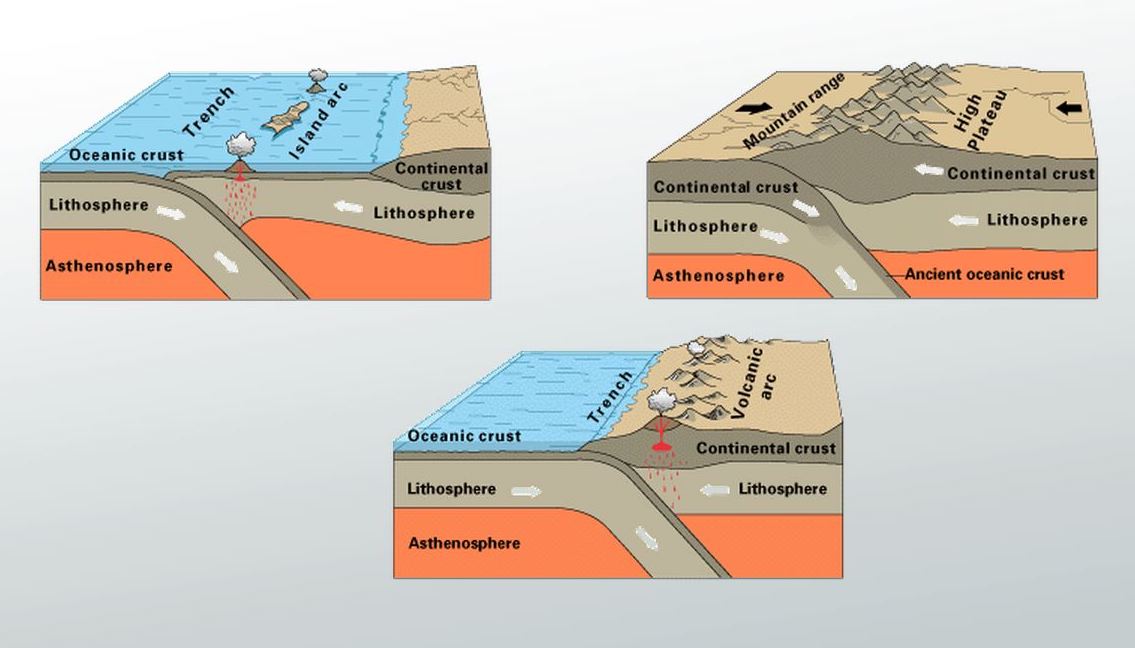Every Year Plates Under the Ocean Move Approximately
Thanks 17 Useless answered. They remained in this slow phase for about 40 million years.

Plate Tectonics 101 What Happens When Plates Move Toward Each Other Landscapes Revealed
It is estimated that the plate moves at a snails pace towards the Atlantic Ocean just 1cm per year.

. Plates move away from each other by 35 cm per year at the mid-Atlantic ridge for a net growth of 7 cm per year for the width of the Atlantic Ocean. It is moving at a speed of around 87 mm every year. This movement can lead to tsunamis.
Every year plates under the ocean move approximately a. Every year plates under the ocean move approximately a. 1 on a question Every year plates under the ocean move approximately a1-2 centimeters b1-2 feet c1-2 yards d1-2 miles - the answers to.
The two types of plates are continental plates which move at 2 cm a year and oceanoceanic plates which move at. The rate at which the Pacific plate is moving over the Hawaiian hot spot can be easily estimated from the geographic and age data. Indo-Australian Plate stretches from the continent of Australia.
They can move away from one another or diverge. Every year plates under the ocean move approximately a. Every year plates under the ocean move approximately 1-2 centimeters.
Thats about how long your fingernails grow in a year. Burma Plate - 1100000 sq km As its name suggests the Burma Plate encompasses the country of Burma Myanmar. Plate tectonics deals with the movements of earths plates.
They can move toward one another or converge. Decks in Environmental Geology Class 7. Approximately 43 million years ago the plate changed its relative direction of motion it had previously been moving in a more northerly direction greater than 43 million years ago.
The answer is s 1-2 centimeters. The fastest plates move more than 4 inches 10 centimeters per year. At the seams where tectonic plates come in contact the crustal rocks may grind violently against each other causing earthquakes and volcano eruptions.
Some sources state that in the North Atlantic the rate of movement is only about 1 cm about 04 in per year while in the Pacific it amounts to more than 4 cm almost 2 in annually while others say that plates in general travel from 5 to 10 cmyr. In the case of the Eurasian Plate it moves at a rate of just 7-14 millimeters per year. About 250 million years ago these plates were all arranged in such a way that they formed one gigantic supercontinent called Pangaea.
This differential movement has resulted in the compression of the former plate near its centre at Sumatra and the division into the Indian and. When to plates pull apart on the ocean floor its called Tectonic Plate Drift or Contenetial Drift This allows countries to move centimeters. Some regions such as coastal California move quite fast in geological terms almost two inches a year relative to the more stable interior of the continental United States.
Or they can slide past one another or transform. How much wider is the Atlantic Ocean today compared to when Columbus discovered the Americas in 1492. This movement can lead to tsunamis.
The relatively fast movement of the tectonic. Eighty million years ago India was approximately 6400 km 3968 miles south of the Eurasian plate. Every year plates under the ocean move approximately 1-2 centimeters.
The eastern part Australian Plate is moving northward at the rate of 56 cm 22 in per year while the western part Indian Plate is moving only at the rate of 37 cm 15 in per year due to the impediment of the Himalayas. Every year plates under the ocean move approximately a. About 1 inch 25 centimeters per year.
They move at a rate of one to two inches three to five centimeters per year. The answer is s 1-2 centimeters. This movement is the earthquake under the ocean and can also be called Submarine earthquake when the intensity goes high.
However over a period of time the movement of plates led to the disintegration of the Pangaea and the formation of the. The largest amongst these plates the Pacific Plate lies beneath the Pacific Ocean. It was formed out of a merger of the Indian Plate and Australian Plate about 40-43 million years ago.
Scotia Plate - 1600000 sq km The Scotia Plate stretches for 16 square km just north of the Antarctic Plate. The majority of the research shows that the plates move at the average rate of between approximately 060 cmyr to 10 cmyr. Convergent Boundaries Where plates serving landmasses collide the crust crumples and buckles into mountain ranges.
Tectonic plates can interact in one of three ways. This movement is the earthquake under the ocean and can also be called Submarine earthquake when the intensity goes high. The majority of the plate is deeply submerged beneath the Scotia Sea.
At about 589 million square kilometers it is the second smallest tectonic plate on Earth. India made its way across the sea toward the Eurasian plate. Mount Everest rose from a tectonic collision that continues to influence its height today.
As India approached Asia. Because Earths tectonic plate boundaries often consist of continent and ocean crust the Eurasian Plate contains parts of the Atlantic and the Arctic Ocean. Then around 200 million years ago the plates entered their fast stage accelerating for 10 million years until they reached speeds of.
Every year plates under the ocean move. All plate tectonics move deceptively slow. Correct answer to the question.

Deep Sea Trench Geology Island Arc Plate Boundaries Subduction Zone

Major Tectonic Plates And Their Approximate Direction Of Movement Placas Tectonicas Geografia Geologia

Plate Tectonics 101 What Happens When Plates Move Away From Each Other Landscapes Revealed
Comments
Post a Comment